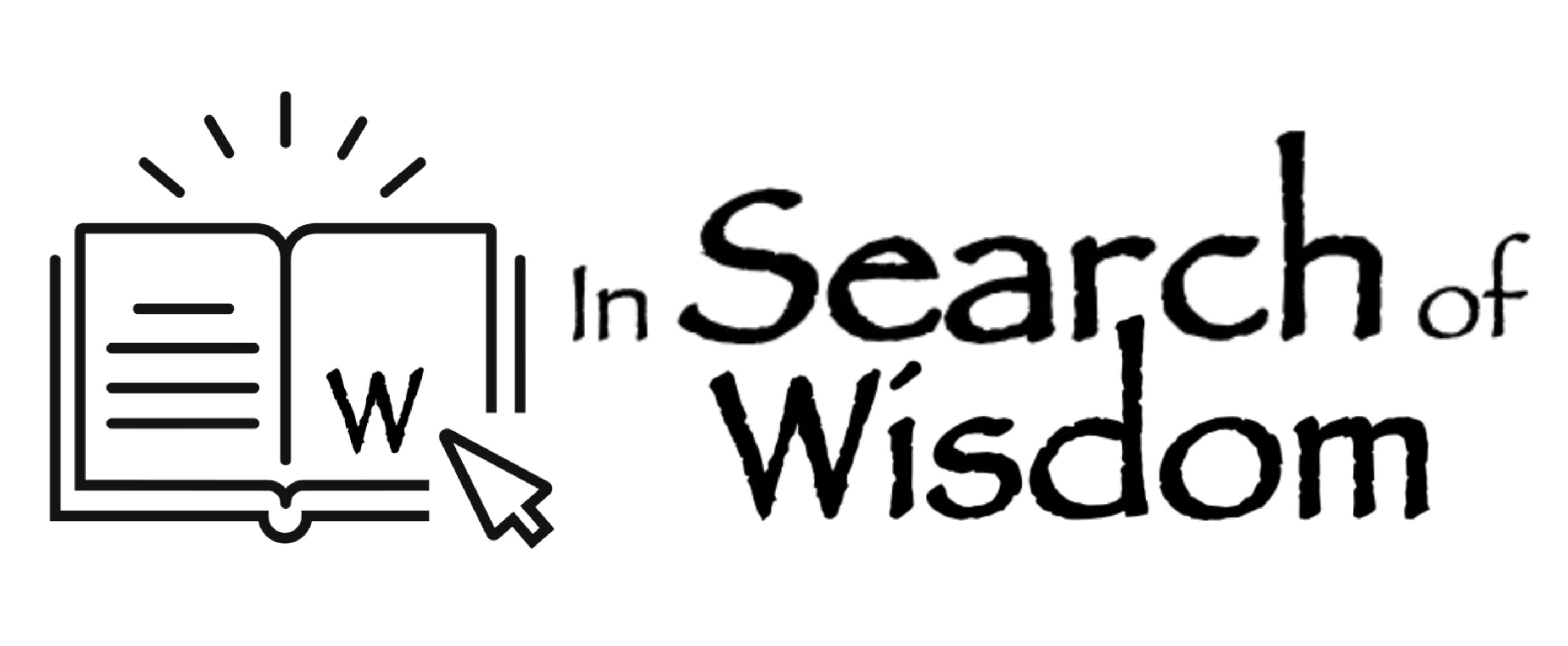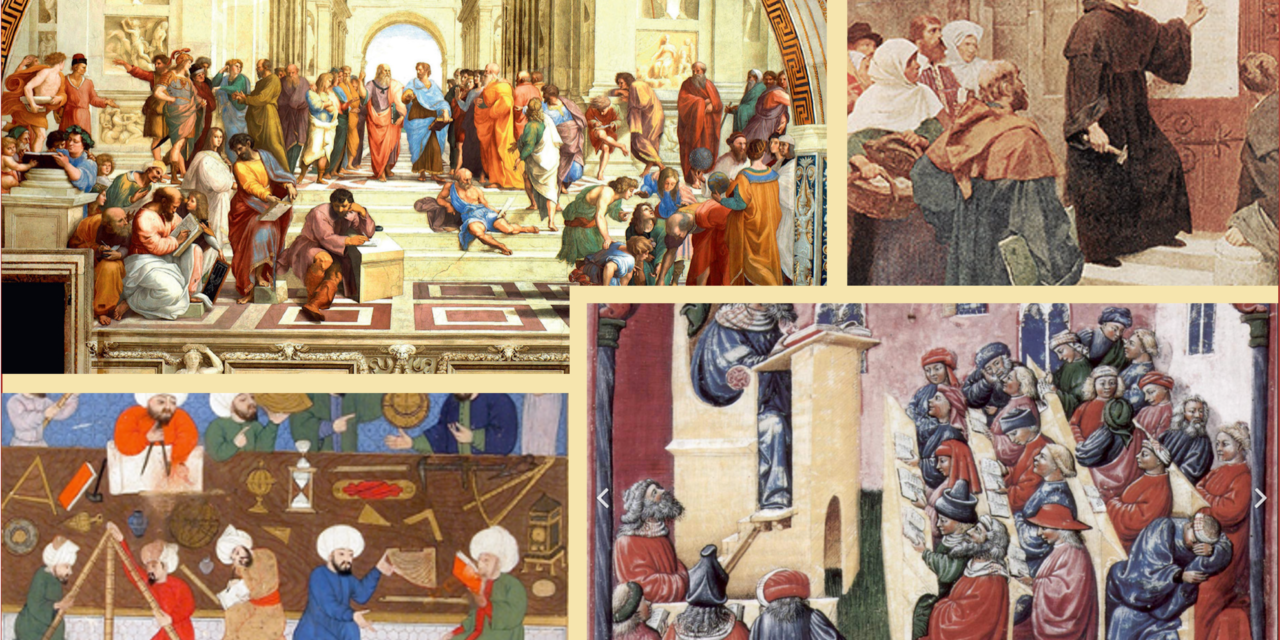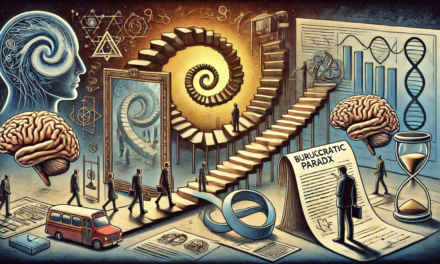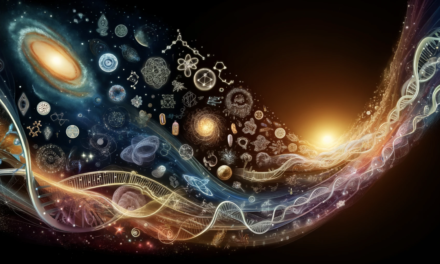Introduction:
Four Movements that Helped to Shape Today’s World
In “The Evolution of Evolution” we summarised the new story of the universe and humanity’s place within it. We saw how the Emmy-award -winning film “Journey of the Universe” was able to incorporate the deepest insights from humanity’s search for knowledge and wisdom into a story based on the latest findings from modern science.
This article reviews humanity’s search for knowledge during the period between the fall of Rome in 476 BCE and the Italian Renaissance in the 14th and 15th centuries. In Western Europe it was marked by a gradual shift from a focus on religion and theological studies towards a renewed interest in classical learning, humanism, and scientific inquiry. This period is often referred to as ‘Medieval’ or ‘the Middle Ages’, and it saw the rise of scholasticism, the development of Christian theology and philosophy, and the spread of Islamic scientific knowledge to Europe. During this time, the Catholic Church played a dominant role in intellectual and cultural life, but this began to change with the emergence of Renaissance humanism in the 14th and 15th centuries which sought to revive the classical learning and intellectual curiosity of ancient Greece and Rome. The 15th Century Protestant Reformation hastened this change. These four movements (scholasticism, Islamic science, Renaissance humanism, and the Protestant Reformation) provided the environment from which the world we know could emerge.
“Roots, not foundations”
Up until now, I have been referring to this period as one in which the ‘Foundations’ of modern science were laid. But the word “foundations” suggests a physical, inanimate structure carefully erected by people and their machines to a pre-existing plan. And that is quite different from how the rudiments of enquiry in the medieval world morphed into the global enterprise of modern science. I prefer the term “roots” because it suggests organic growth rather than mechanical construction. As Merlin Sheldrake reminds us in his best-selling book, “Entangled Life”, “organisms grow; machines are built. Organisms continually remake themselves; machines are maintained by humans. Organisms self-organise; machines are organised by humans.” He could have added that organisms develop in the environment they find themselves in, whereas machines are built for specific environments.
The more I delved into the subject, the more sensible it seemed to me to use an organic metaphor for the development of science than a mechanical one. The instinct to talk in terms of machines is natural; after all, the idea of God as the “Deus ex-Machina” emerged from the so-called “Scientific Revolution” in the Western Europe of the 17th and 18th centuries (the subject of module six). But modern scholarship reveals numerous roots that draw ideas and inspiration from cultures and regions in many parts of the world. Just as information is today dissipated globally by a worldwide communication network based on electronic communication, so in the Middle Ages, the cultures of Islamic North Africa and Asia, Persia, India, and China were all joined by a commercial network – the so-called “silk roads”. And news of discoveries old and new flowed across it in all directions.
Christendom and Islam
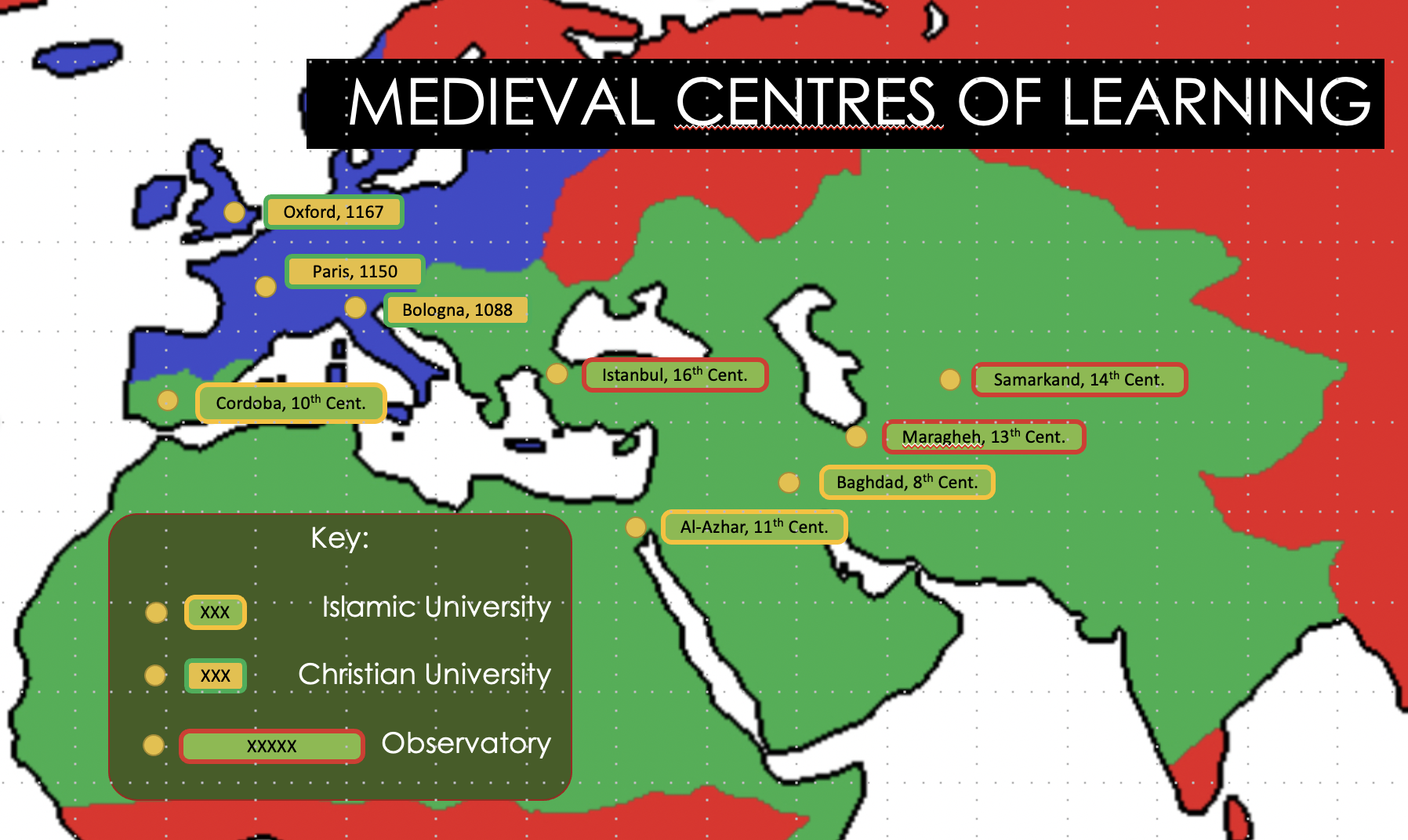
Introducing his lecture on “The Birth of Modern Science”, Professor Steven Goldman writes, “One enduring mystery of modern science is why it developed where and when it did. Had modern science emerged in late Greco-Roman antiquity, in 11th- or 12th-century Islam, or China after the Tang dynasty, there would be no mystery. But for it to emerge in the Christian culture of 17th-century western Europe was, in retrospect, surprising.”
A glance at the relative reach of Christianity and Islam indicated in the diagram above suggests why he might have said that. The green areas show lands where Islam was the dominant religion at some time between the seventh and sixteenth centuries. In contrast, the blue shows the extent of Christendom after the fall of Constantinople and the Eastern Roman Empire in 1492 CE.
Medieval Islamic Learning
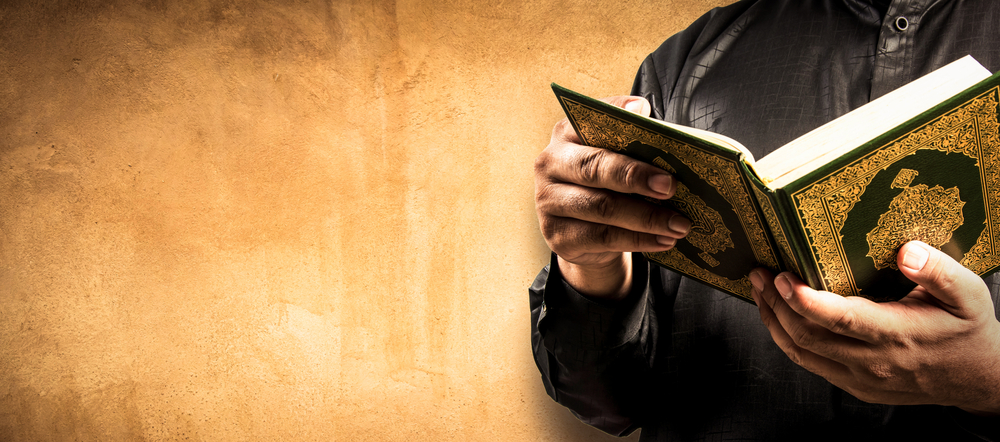
The sacred Islamic scriptures make it clear that “learning” is central to Muslims, as seen in the following quotations. “Seeking knowledge is an obligation on every Muslim.” “He who goes forth in search of knowledge, God will cause him to be guided to the paths of righteousness.” And “The pursuit of knowledge is a sacred duty for every Muslim, male and female.”
Because of this, Muslim rulers (known as Caliphs) patronised the sciences and centres of learning. They also established observatories to make calendars and the dates of specific festivals as accurate as possible.
As early as the 8th century CE, the “House of Wisdom” was founded in Baghdad, under the patronage of Caliph Harun al-Rashid, as a centre of learning and scholarship. Over the following centuries, as Islamic rule expanded throughout Persia to the borders with India, Islamic scholars were exposed to mathematical and astronomical knowledge from India and even further afield, from China. The House of Wisdom was a vast library and research centre intended to gather, translate, and preserve the ancient world’s knowledge, including works from ancient Greece, Rome, Persia, India, and other civilisations. Its scholars translated these works into Arabic and produced new documents of their own, making significant contributions to fields such as mathematics, astronomy, medicine, philosophy, and literature.
It was also a centre for debate and discussion, where scholars of different backgrounds and beliefs could exchange ideas and advance knowledge. It played a significant role in transmitting ancient knowledge to the Islamic world and to later generations, and it is considered a key institution in the history of Islamic civilisation.
In the West of the Islamic Empire, in the 10th century CE during the reign of the Caliph Ad al-Rahman III, the “House of Knowledge” was established in Cordoba, Spain. Modelled on the House of Wisdom in Baghdad, it also served as a centre for scholarship and research in diverse fields, including mathematics, astronomy, philosophy, medicine, and literature. It housed a vast library of manuscripts and books and attracted scholars and students from all over the Islamic world.
One of the most famous scholars associated with the House of Knowledge was the philosopher and polymath Ibn Rushd, known in the West as Averroes, who lived in the 12th century CE. He made significant contributions to philosophy, law, medicine, and theology, and his works profoundly influenced later scholars in both the Islamic world and Europe.
Egypt had played a part in creating knowledge and learning since the dawn of history, and under the Pharaohs, astronomy and mathematics flourished in the third millennium BCE. In the 4th century BCE, under Alexander the Great and the Ptolemy dynasty that succeeded him, the library of Alexandria was a global centre of Greek and ancient knowledge that was second to none.
During the Islamic period, it was also a significant centre of learning, with the founding in 970 CE of the al-Ahzar University in Cairo. It was initially established as a centre of Islamic research, focusing on Quranic studies, Islamic law, and the Arabic language. Over time, the university expanded to include faculties of medicine, engineering, agriculture, and other fields of study. Al-Azhar University is still among the most prestigious institutions of higher learning in the Muslim world. Its scholars are respected for their expertise in Islamic jurisprudence and other areas of Islamic scholarship.
Islamic Contributions to Mathematics
One lasting contribution made by Islamic scholarship to the development of modern science was in the field of mathematics. That is reflected in current terms such as algebra and algorithm. Islamic scholars were much more than simply custodians of Greek learning. They played a crucial role in bringing together the algebraic and arithmetical traditions of Mesopotamian, Indian and Chinese mathematics with the geometry developed in Greece and the Hellenistic world.
For example, they adapted the Indian numerical notation system, also known as the decimal system, including the use of positional numbers and the number zero. One of the most notable figures in this development was the Persian mathematician Al-Khwarizmi, who lived in the 9th century and is often referred to as the “father of algebra.”
Al-Khwarizmi and other Islamic mathematicians recognised the advantages of the decimal system’s positional notation, which allowed for a more efficient and systematic method of arithmetic and calculation. They also recognised the importance of zero as a placeholder, greatly expanding the range of numbers that could be represented and enabling more sophisticated mathematical calculations.
Through the works of Islamic scholars such as Al-Khwarizmi, the decimal system and positional notation were adopted by merchants and traders and eventually became widespread throughout the Islamic world. Their methods were later transmitted to Europe during the Middle Ages, where they gradually replaced the previous Roman numeral system.
Troubles with Ptolemy

Throughout the Medieval world of both Islam and Christendom, Astronomy was highly valued. It had both religious and political implications for the ruling authorities. It mattered to religious leaders because, in Christianity, it was essential to calculate the date of Easter based on the moon’s movement. In Islam, the observation of celestial bodies was necessary for determining the times of prayer, the direction of the qibla (the direction of Mecca), and the dates for the holy month of Ramadan and other religious observances.
Astronomy also had political significance. Knowledge of the heavens was necessary for determining auspicious times for battle, coronations, and other political events. Rulers and political elites often supported astronomical research and patronised scholars who were experts in the field.
For these reasons, astronomy was a critical scientific discipline in both the Islamic and Christian worlds. Scholars from both traditions recognised the importance of studying the heavens to understand the natural world better. Astronomical observations helped develop more accurate calendars, navigational tools, and mathematical models of the universe. Crucially, the medieval Islamic and Christian worlds were connected by trade, pilgrimage, and intellectual exchange, so astronomy was one area where scholars from both traditions could share knowledge and learn from one another. Many Islamic works on astronomy were translated into Latin and other European languages, contributing to the development of astronomy in the West.
It was universally accepted in the Middle Ages that the Earth was the centre of the universe. Both the stars and planets were thought to revolve around the Earth in roughly spherical paths (see the diagram above}. The classical text which described these movements was the “Almagest”, written in Greek by the astronomer and mathematician Ptolemy in the 2nd century CE. Based on observations of the heavens, it was more accurate than earlier Greek models, such as those proposed by Aristotle and Hipparchus.
More accurate, but only partially so. To account for the fact that planets sometimes appear to move backwards in the sky, Ptolemy had invented a series of so-called “epicycles” (small circles within larger circles). A scholar in Baghdad’s “House of Wisdom”, Al-Haytham (also known as Alhazen), was the first to publish a criticism of the Almagest, suggesting that it did not accurately describe the movements of the planets and stars. He criticised the use of epicycles as a mathematical convenience rather than an accurate representation of the universe; consequently, they could not accurately predict the positions of celestial bodies. In his work, “Doubts concerning Ptolemy”, which he wrote in 1028 CE, Al-Haytham proposed an alternative model of the universe, which placed the Sun at the centre rather than the Earth.
But Al-Haythem was merely the first to raise serious questions about Ptolemy’s model. Other Islamic translators of ancient Greek scientific texts added their commentaries and critiques. Perhaps the most influential among them was Nasir al-Din al-Tusi, the leading astronomer at the Maragheh observatory in Northern Persia. In his “Memoir on Astronomy” (1261) al-Tusi not only criticised Ptolemy’s model of the universe, but he offered a solution by inventing a piece of geometry now known as the “Tusi couple”. This idea was later to have a profound influence on astronomy’s development in Western Europe.
The Maragheh observatory inspired Ulugh Beg, grandson of Tamerlane, to build an observatory in Samarkand where, in 1437, Ali Qushji published the “Tables of the Sultan”. At the time, it was the most accurate collection of astronomical measurements that had been made, and it would remain so for the next 150 years. It was also published roughly the same time European astronomers and other scientists entered a period known as the Italian Renaissance. A period that has traditionally been seen as marking the beginning of the “Scientific Revolution”.
But before we consider the Renaissance, we should briefly review what had been happening in Medieval Christendom.
Learning in Medieval Christendom
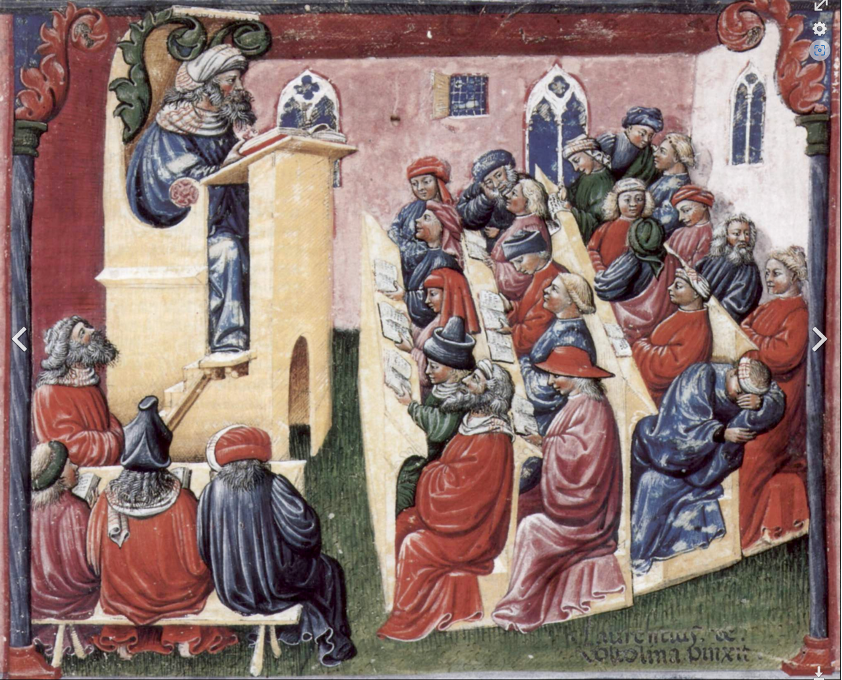
The growth of towns and cities during the Middle Ages provided a new cultural and intellectual environment. The development of trade and commerce and the expansion of the Catholic Church created a demand for educated individuals who could serve as clerks, lawyers, and teachers.
Traditionally, knowledge was primarily gained through apprenticeships, religious institutions, and the transmission of knowledge through the family or community.
Apprenticeships were a common way for individuals to learn a trade or craft. Young people would be taken on as apprentices by a master craftsman, who would train them in the skills and knowledge necessary to become skilled workers. This system was widespread in the medieval period and was used to pass on knowledge of trades such as blacksmithing, carpentry, and weaving.
Religious institutions, particularly monasteries and convents, were also important centres of learning. Monks and nuns were often educated and spent their time copying and producing manuscripts, preserving knowledge of ancient texts and scientific discoveries. They also provided education to young people who entered the religious life.
In addition, families and local communities passed on their knowledge from generation to generation. Parents would teach their children the skills necessary for their profession or trade, while communities would share knowledge of local customs, traditions, and practices.
These three ways together, however, proved incapable of supplying the demand for educated individuals. As a result, the first universities as we know them today were founded in the 12th and 13th centuries. The exact date of the founding of the first university is debated, but some of the earliest institutions that can be considered universities include the University of Bologna (established in 1088), the University of Paris (established around 1150), and the University of Oxford (established around 1167).
These early universities were centres of learning where students could study a wide range of subjects, including theology, law, medicine, and the liberal arts. They were different from the traditional schools of the time, which were focused on preparing students for a specific profession or trade, and offered a more comprehensive and integrated curriculum.
Although theological orthodoxy was highly valued and carefully protected by the church authorities, it was widely accepted that God reveals Himself through His “two books”: The Book of Scripture and the Book of Nature. Both sources were important for understanding the divine will. Consequently, the curriculum at medieval universities was based on the seven liberal arts, which were divided into two categories: the trivium and the quadrivium.
The trivium consisted of grammar, logic, and rhetoric. Grammar was concerned with the correct use of language and the study of Latin, which was the language of scholarship and the Church. Logic was the study of reasoning and argumentation and was a critical tool for understanding the natural world and engaging in philosophical inquiry. Rhetoric was the art of persuasive speaking and writing and was an essential skill for lawyers, theologians, and others who needed to make compelling arguments in public forums.
The quadrivium consisted of the four subjects of arithmetic, geometry, astronomy, and music. These subjects were the mathematical sciences and were concerned with understanding the underlying patterns and structures of the natural world.
Together, the trivium and quadrivium comprised the medieval university’s core curriculum. Students were expected to master these subjects before moving on to more specialised studies in law, theology, or medicine. The curriculum was highly structured and tightly regulated, and students were expected to complete their studies within a set number of years.
Two Mediaeval Scholars Who Fostered the Development of Science
Roger Bacon
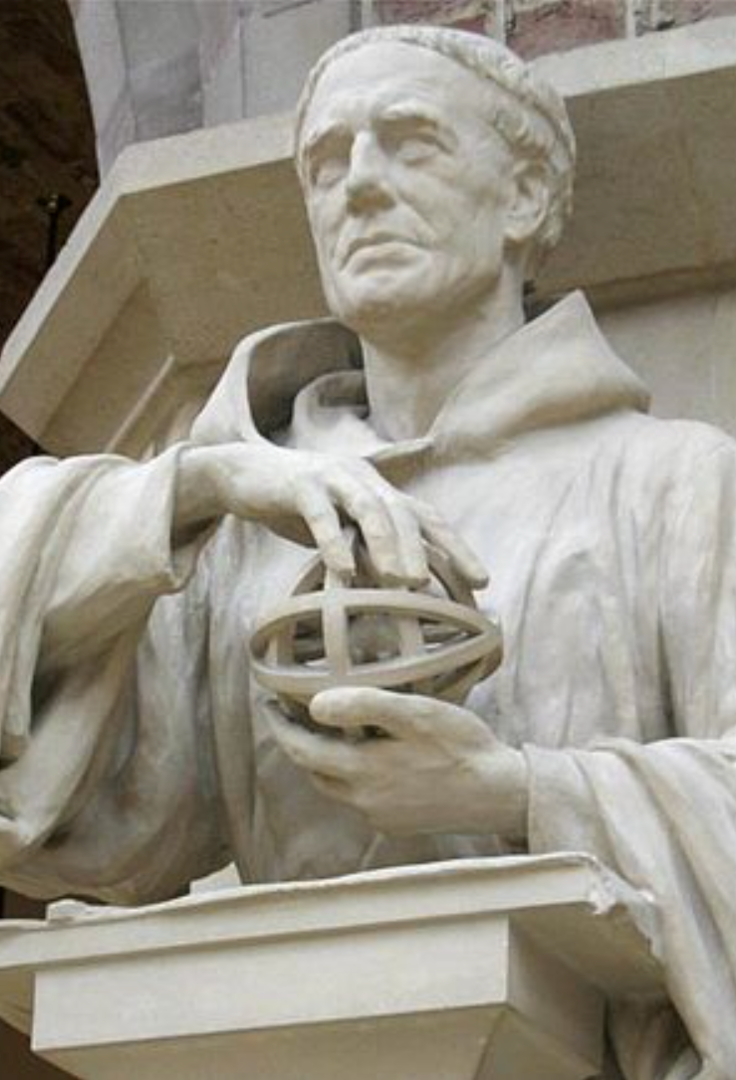
Roger Bacon (c. 1214/1220 – c. 1292) was an English philosopher and Franciscan friar who made significant contributions to the fields of optics, linguistics, and experimental science. He is also known for advocating for the study of mathematics, languages, and natural philosophy as important foundations for the study of theology.
Bacon was born in Ilchester, Somerset, England, and entered the Franciscan Order at a young age. He studied at Oxford and later at the University of Paris, where he became interested in the works of Aristotle and the Muslim philosopher Avicenna. Bacon was critical of the Aristotelian philosophy that dominated medieval thought, arguing that it relied too heavily on logic and lacked empirical evidence.
Bacon’s most important contributions were in the field of optics. He developed a theory of vision that emphasised the role of light in perception and argued that vision occurs through the refraction of light by the eye. He also conducted experiments with lenses and mirrors, and his work laid the groundwork for developing spectacles and telescopes.
In addition to his work in optics, Bacon contributed to linguistics by advocating for the study of languages as a means of understanding different cultures and developing machine-readable alphabets. He also wrote about alchemy and the natural sciences, arguing that experimentation and observation were essential for studying nature.
Bacon’s ideas were influential in developing the scientific method, emphasising observation and experimentation in studying natural phenomena. Although his ideas were controversial in his own time, his work was rediscovered during the scientific revolution of the 17th century and continues to be studied by scholars today.
Thomas Aquinas
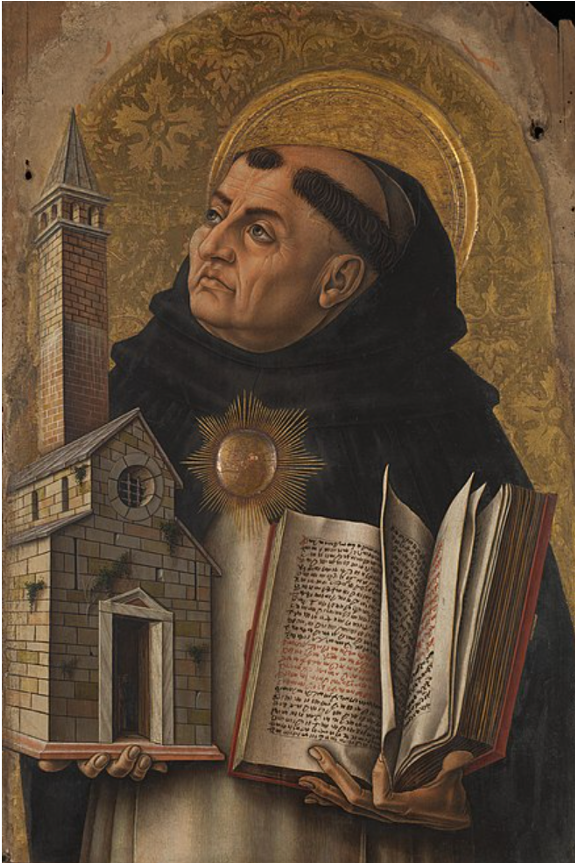
Thomas Aquinas (1225-1274) was an Italian Dominican friar, theologian, and philosopher who significantly contributed to theology, philosophy, and natural science during the medieval period. He is best known for synthesising Aristotelian philosophy and Christian theology in his magnum opus, the Summa Theologica.
Aquinas was born into a noble family in Aquino, Italy, and began his studies at a young age. He joined the Dominican order in 1244 and studied theology and philosophy at the University of Paris. Aquinas was deeply influenced by the works of Aristotle, which had been recently translated into Latin, and he sought to reconcile Aristotelian philosophy with Christian theology.
Aquinas’ most significant contribution to science was his integration of Aristotelian natural philosophy with Christian theology. He believed that God had created the natural world and that it was the duty of humans to understand and appreciate it. He also argued that reason and faith were compatible and complementary and that both were necessary for understanding the world.
Aquinas’ understanding of the natural world profoundly impacted medieval science. His work on the nature of causation, substance, and change helped establish a framework for studying the natural world. He also contributed to the study of optics, arguing that the mind perceives the forms of things rather than their physical substance.
Aquinas’ influence extended far beyond the medieval period. His ideas on the nature of God, morality, and natural law continue to be studied by philosophers and theologians today. He is regarded as one of the greatest thinkers in the history of Western philosophy, and his synthesis of reason and faith remains a powerful legacy.
The Rediscovery of Aristotle
Bacon and Aquinas were not the only scholars interested in Aristotle, as fresh Latin translations became available through Islamic intermediaries. And while Aristotle’s ideas eventually became a central part of medieval education and philosophy, there was initially significant resistance to his teachings within the Church. In the early Middle Ages, Christian thinkers relied heavily on the works of St. Augustine and other early Church fathers for their theological and philosophical ideas. They viewed Aristotelian philosophy as threatening the Christian faith and sought to suppress it.
The Church’s attempts to suppress Aristotle’s ideas began in the 13th century, with the work of Bishop Stephen Tempier of Paris. In 1270, Tempier issued a list of 219 condemned propositions, many of which were based on Aristotelian philosophy. These propositions included ideas such as the eternity of the world, which contradicted Christian doctrine.
Despite the condemnation of specific Aristotelian ideas, the works of Aristotle continued to be studied and discussed in medieval universities. Thomas Aquinas was not alone in believing that Aristotelian philosophy could be reconciled with Christian theology, and the influence of his thinking on the Church gradually prevailed.
In the late 13th century, some members of the Church began to embrace Aristotelianism. Pope John XXI was an enthusiastic proponent of Aristotelian philosophy, and he encouraged the study of Aristotle’s works in universities. However, the Church remained cautious about using Aristotelian ideas, and many theologians continued to view them with suspicion.
By the 14th century, Aristotelianism had become a central part of medieval education, and the Church’s attempts to suppress it had largely failed. The Church recognised that Aristotelian philosophy had many valuable insights into the natural world, and it became an essential part of the intellectual and philosophical traditions of the Middle Ages.
The Italian Renaissance
Aristotle’s emphasis on using reason and logic to understand the natural world and human behaviour provided a powerful alternative to traditional medieval theology, which relied heavily on authority and faith. The study of Aristotelian philosophy also helped to fuel the Renaissance, a broader intellectual and cultural awakening in Italy during the 14th and 15th centuries.
Aristotle’s emphasis on the importance of empirical observation and logical deduction helped to shape the emerging scientific method, which played a vital role in the development of Renaissance science. The Renaissance also saw a renewed interest in classical art and literature, inspired by a desire to emulate the achievements of ancient Greece and Rome.
But this intellectual movement gained massive impetus from the fall of Constantinople in 1453. Constantinople, the capital of the Byzantine Empire, was an important cultural and intellectual centre that had preserved much of the knowledge of ancient Greece and Rome. When the Ottoman Turks conquered Constantinople, many Byzantine scholars and intellectuals fled to Italy, bringing a wealth of knowledge and cultural treasures.
These scholars brought classical texts, ancient manuscripts, and a deep knowledge of Greek and Roman culture and philosophy. They helped spark a renewed interest in classical learning and culture, which profoundly impacted Italy’s intellectual and artistic life. Many of them found employment in Italian universities, where they taught Greek and Latin and helped to revive the study of classical literature.
The rediscovery of classical knowledge and the Ottoman Empire’s expansion coincided in the 15th and 16th Centuries with a significant growth in trade and commerce which produced a wealthy merchant class who had the money to patronise the arts, literature, and science. At the same time, a growing sense of individualism and the power of human reason helped to erode the Church’s political and social control.
Together, these developments ushered in four dominant 16th and 17th-century movements that fuelled the growth of modern science and the modern world: humanism, moveable-type printing, the discovery of the “New World”, and the reform of Christendom.
Humanism
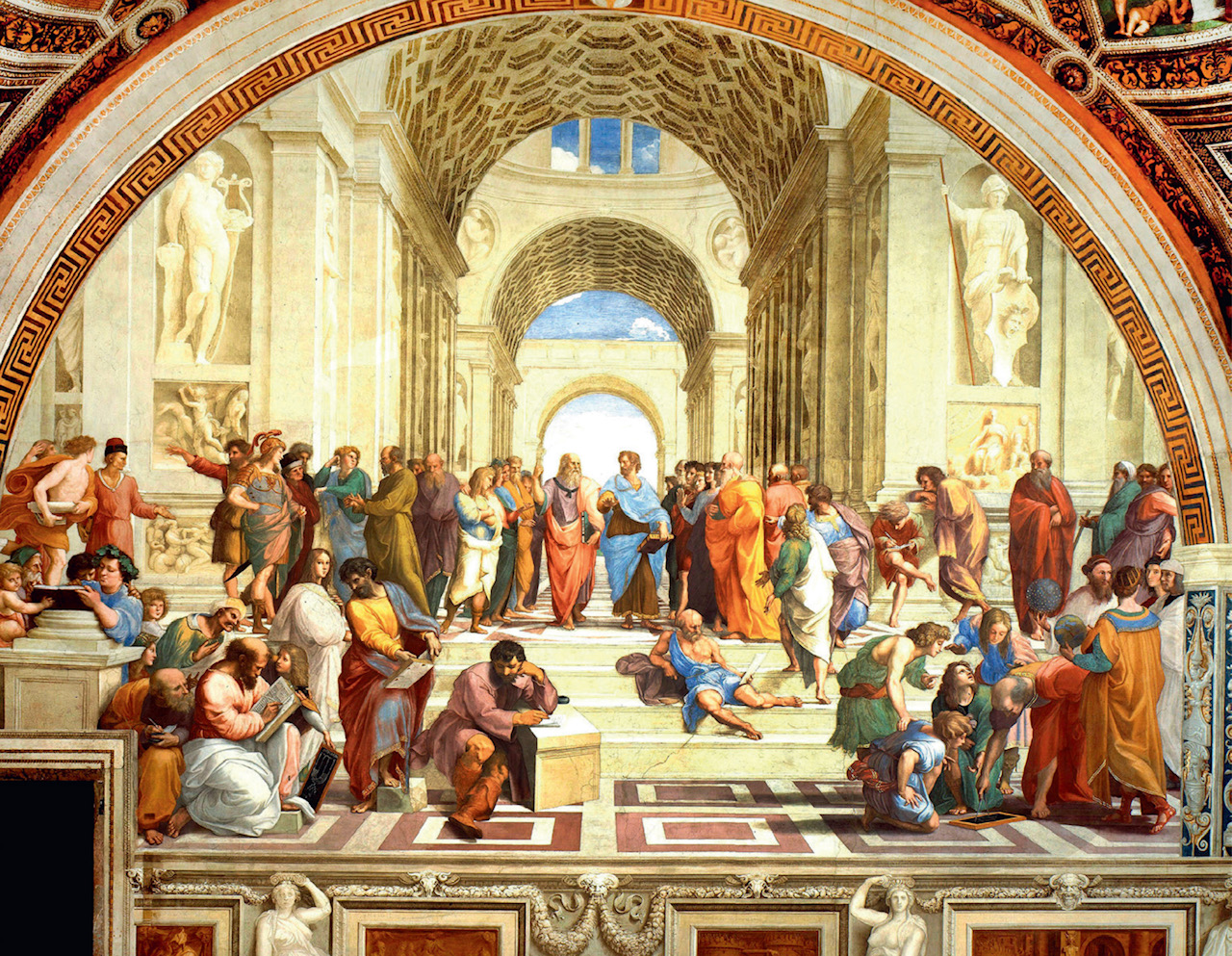
Renaissance humanists are not to be confused with modern secular humanists. Humanists were scholars who focused on studying human nature, language, literature, and history, particularly emphasising the classical cultures of Greece and Rome.
The Renaissance humanists believed that studying classical literature and culture could help create a more enlightened and virtuous society. They thought that the knowledge and wisdom of the ancients could be used to guide and inform contemporary society. They also believed that studying language, literature, and history could help develop human reason and critical thinking skills, which were essential for advancing knowledge and understanding.
Humanists were critical of the scholasticism and Aristotelianism that had dominated medieval education. They believed medieval philosophy was too abstract and removed from the concerns of everyday life. Instead, they sought to ground their ideas in the realities of human experience and the natural world.
Humanism had a profound impact on the intellectual and cultural life of Europe. It helped spark a renewed interest in classical learning, language, and literature, which profoundly impacted the development of Renaissance art, architecture, and science. Humanism also contributed to the development of the modern concept of the individual, emphasising the importance of reason, free will, and self-determination. Today, the legacy of Renaissance humanism can be seen in the continuing importance of the humanities and in the belief that studying language, literature, and history is essential for a well-rounded education.
Movable-type Printing
The invention of movable-type printing revolutionised the printing industry and significantly impacted the spread of knowledge and the development of the modern world.
The movable-type printing process involves creating individual characters, such as letters or numbers, and arranging them in a frame to create text. These characters can then be used repeatedly to make multiple copies of the same text. The use of movable type allowed for greater printing flexibility and increased efficiency and speed.
The first known use of movable type was in China, invented by Bi Sheng in the 11th century. However, it was widely used in the 14th century, when the Korean printer Choe Yun-ui refined the technology. It reached Europe in the 1440s when Johannes Gutenberg
developed a press that used individual metal letters capable of being rearranged to create different words and sentences.
Movable-type printing had a profound impact on the spread of knowledge and ideas. It allowed for the rapid production of books and other printed materials, which made it easier for people to share and disseminate information. This, in turn, helped to fuel the growth of the Renaissance and the scientific revolution.
Discovery of the “New World”
The discovery of the Americas brought new knowledge, resources, and opportunities that helped shape Europe’s intellectual and economic landscape in the centuries that followed.
Culturally, the discovery of the New World had a profound impact on the way that Europeans thought about the world. The new knowledge of the Americas challenged many long-held assumptions about the natural world, and the encounters with new cultures and peoples led to a rethinking of traditional notions of race, ethnicity, and identity. This led to a broader questioning of established ideas and a greater openness to new perspectives and ways of thinking. Its impact was amplified by the availability of printed books containing detailed engravings of the newly-discovered cultures, flora and fauna.
The discovery of the New World also had a significant economic impact on Renaissance Europe. The abundance of resources and wealth found in the New World helped fuel the growth of the European economy, particularly in the areas of trade and commerce. The discovery of gold, silver, and other valuable resources brought enormous wealth to Europe, and the new trade routes established with the Americas helped expand European commerce and trade networks.
The Reform of Christendom
In 1517 a German monk and theologian called Martin Luther proposed his “ninety-five theses” for the reform of the Church. These dealt with topics such as the sale of indulgences, the authority of the pope, justification by faith, and the use of the vernacular for worship. The proposed reforms were politicised by German (and other) rulers already seeking separation from Rome and set in motion a century and a half of “wars of religion” across Western Europe.
The movement had a significant impact on the Church and society. Many religious thinkers, for example, believed that the Church had strayed too far from its roots and that it needed to return to a simpler and more authentic form of Christianity. Their ideas led to a movement of reform that focused on the study of the Bible, the renewal of religious life, and the rejection of some of the excesses of medieval church practice.
The reform of Christendom also significantly impacted the development of science, particularly through its emphasis on the study of the Bible. The renewed focus on scripture study led to a greater interest in the natural world and the belief that learning about the world through observation and experimentation was possible. This emphasis on observation and experimentation helped lay the groundwork for developing the scientific method.
The reform of Christendom also had a profound impact on the way that Europeans thought about the natural world. Many religious thinkers believed that the natural world was a reflection of the glory of God and that studying it was a way to understand the divine better. This belief helped to inspire a renewed interest in the study of the natural world, and many scientists saw their work as a way better to understand the beauty and complexity of God’s creation. Interest was further fuelled by the breathtaking discoveries being reported from the new world and by Christian missions to Southeast Asia.
The Scientific Revolution and the Enlightenment
Even in the Middle Ages, mathematics and astronomy were not the only sciences studied intensively. For example, alchemy (the forerunner of chemistry) and medicine were also widely explored. If we had examined the roots of these subjects, we would also have discovered roots extending far beyond the confines of Greece and Europe. But we have seen enough to show it is misleading to picture science emerging from a classical Greek culture that was lost during the Dark Ages, opposed by the Medieval Church, rediscovered in Renaissance Europe, and finally transformed by the Scientific Revolution. The roots of science are global and have been nourished by diverse religious traditions.
Our brief review has brought us to the brink of what is generally known as the “Scientific Revolution” and the Enlightenment. But before we discuss the seismic shifts to our understanding of science, philosophy, and religion brought on during the 17th and 18th centuries, we will take a final look at Renaissance science and one of its best-known figures: Nicolaus Copernicus.
Nicolaus Copernicus – the Beginning of the Scientific Revolution?
“The Copernican Revolution” is how many people in the West describe the paradigm shift from the Medieval geocentric model of the heavens, in which the Earth is stationary at the centre of the universe, to the modern heliocentric model with the Sun at the centre of the solar system. For example, the philosopher of Science, Thomas Kuhn, wrote a book called “The Copernican Revolution”. In it, he says, “The Copernican Revolution was a revolution in ideas, a transformation in man’s conception of the universe and of his own relation to it. Again and again, this episode in the history of Renaissance thought has been proclaimed an epochal turning point in the development of Western man.”
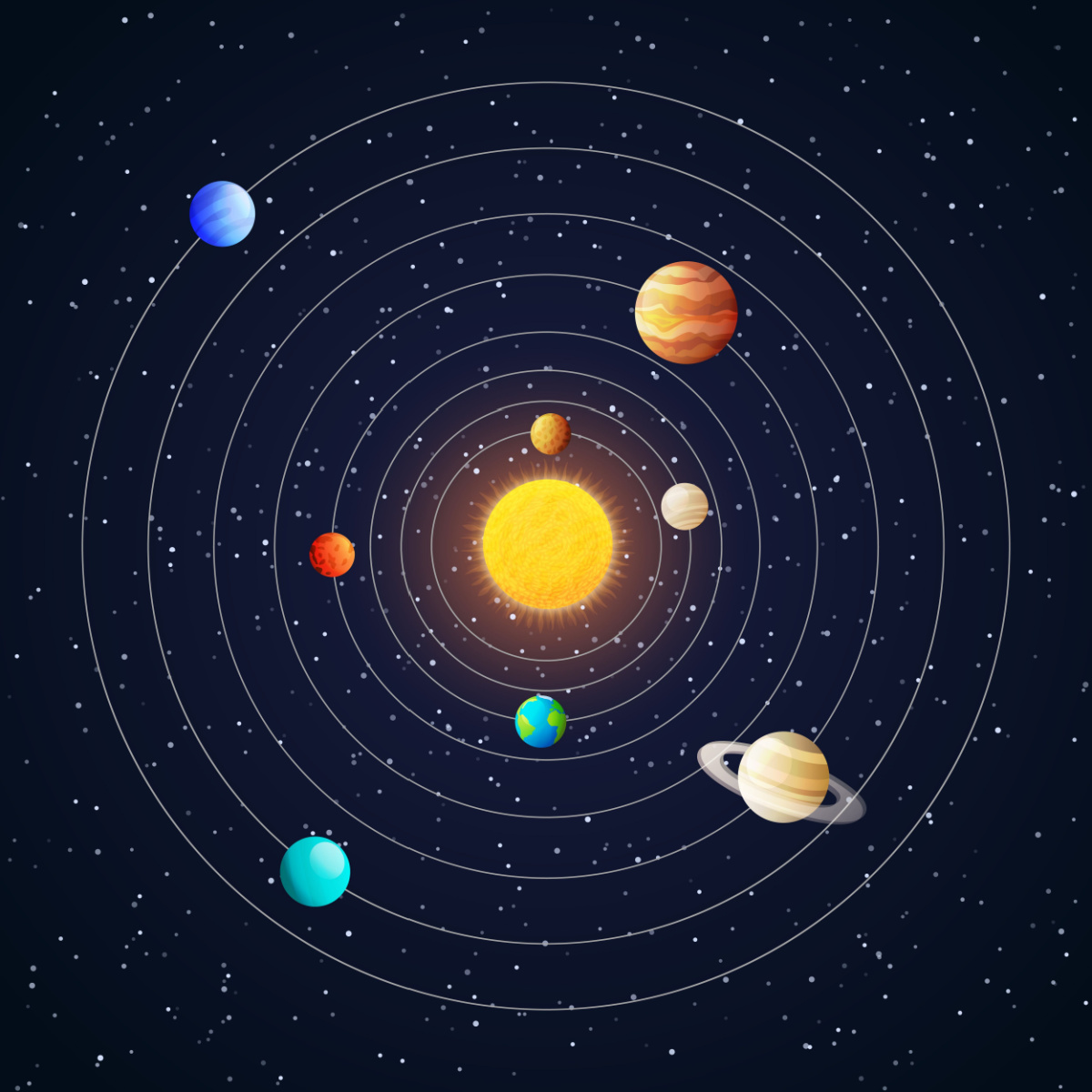
But if his ground-breaking 1543 publication “On the Revolutions of the Heavenly Spheres” did indeed mark the germination of the Scientific Revolution that would later grow to become modern science, then, as we have seen in this article, its roots drew nourishment from a rich and diverse history. Sources that he drew upon in his publication included:
- Ancient Greek astronomy: Copernicus studied the works of ancient Greek astronomers such as Aristarchus, who proposed a heliocentric model centuries before Copernicus.
- Ptolemy’s Almagest: Ptolemy’s work was the standard astronomical text of Copernicus’s time and presented a geocentric solar system model. Copernicus used Ptolemy’s observations of the planets to develop his own theories.
- The works of Islamic astronomers: During the Middle Ages, as we have seen, Islamic astronomers made significant contributions to the study of astronomy. Copernicus was familiar with the works of Al-Haythem and Al-Tusi, among others.
- Observations made with the naked eye: Copernicus made observations of the planets and stars using the naked eye, which informed his understanding of the movements of celestial bodies.
- Regiomontanus’s astronomical tables: Copernicus used the astronomical tables developed by Johannes Müller, also known as Regiomontanus, to make his own observations and calculations.
- Mathematical principles: Copernicus was trained as a mathematician and relied heavily on mathematical principles to develop his theories. He used concepts such as trigonometry and geometry to understand the movements of the planets. As we have seen, these mathematical principles were created from a synthesis of Greek geometry with Indian arithmetic, Arabic algebra, and trigonometry, with its roots in Egypt, Babylon, Greece, China, India, and the Islamic world.
Copernicus drew together all these sources, finally putting to rest the controversies about Ptolemy’s model of the universe, which had rumbled on for centuries. The Renaissance provided a favourable environment to cultivate the ideas that ultimately developed into modern science. But as we have glimpsed, the ideas had genuinely global roots.
Terry Cooke-Davies
March 2023
